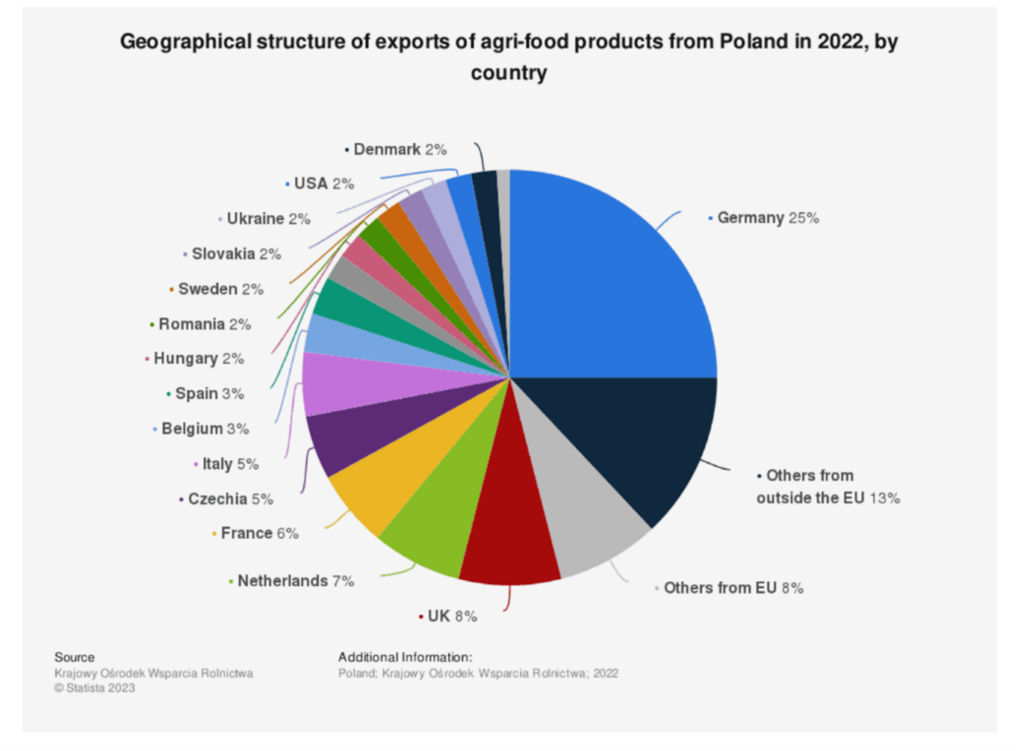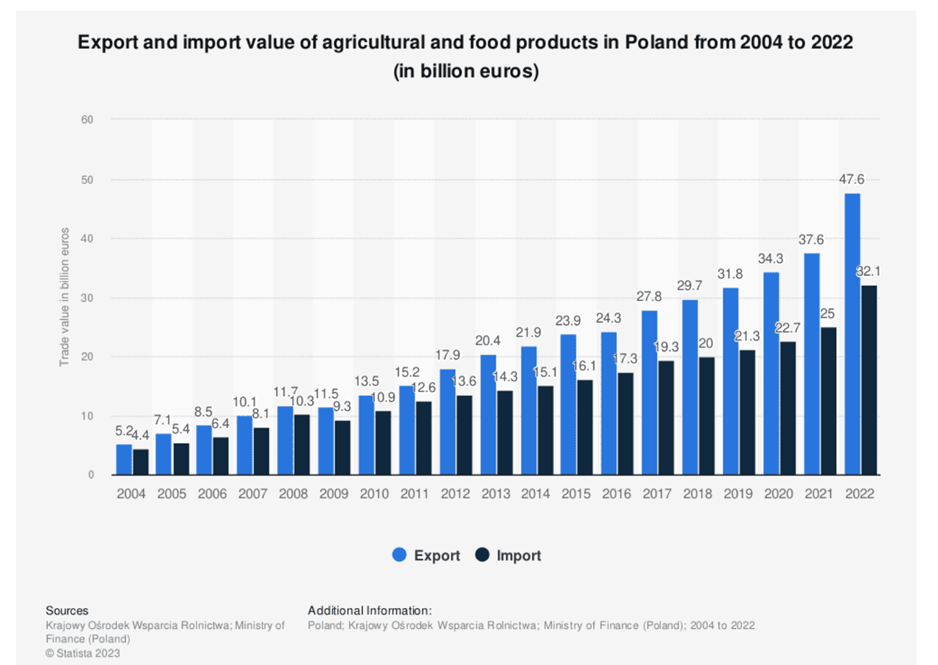2024 – Poland – an agri-food sector with high performance and untapped potential
Regional event introduction
Tuesday, Jul 23, 2024
On Wednesday, November 27, 2024 the Forum moves to Poland for our next regional event ahead of the country assuming the Presidency of the European Union Council from January – June 2025. Here we take a look at agriculture in a country that makes an impressive contribution to European food security.
Polish agriculture is extremely important both for the country’s economy, social advancement and environment, and to consumers’ food in the EU and elsewhere.
With 52% of the land area given over to farming[i], Poland is a major exporter of agri-food products. The country’s gross value added (GVA) from agriculture, forestry and fisheries combined is twice as high[ii] as the EU average. In 2023, Poland was the fifth biggest contributor[iii] to the EU agriculture sector, only coming behind the big four of France, Germany, Italy and Spain.
Source – via Blue Europe https://www.blue-europe.eu/analysis-en/short-analysis/agriculture-in-poland-a-comprehensive-overview
Poland’s agricultural output has been achieved despite the current global challenges facing farmers everywhere. As in many countries, Poland faces increased energy and fertilizer costs, the effects of climate change, and geopolitical instability. Russia’s war on Poland’s neighbour Ukraine has led to additional internal tensions: Poland is among the leading grain producers in the EU[iv] and Ukrainian imports, in particular grain, have fuelled anger and protests among Polish farmers.
Farming has long been a mainstay of Poland’s largely rural economy. Today, the main sectors are dairy, cereals, pigs, poultry and horticulture. Rural areas account for 85% of the land and are home to 15 million people or 38% of the 38 million population[v] [vi]. The Central Statistical Office (CSO) reports[vii] that Poland has over 1.3 million farms with a diversity of structure: many of them are smaller and family farms are seen as pivotal[viii] to economic success and social conditions. Just over 40,000 farms have an area larger than 50 ha, whilst there are over 106,000 farms in the 20-50 ha range. According to this data, as many as 974,000 farms have an area of no more than 10 ha – as many as 75% of all farms in the country. Larger farms with an area over 50 ha have only a slightly more than 3% share in the country’s farm structure.
The country has the second biggest agricultural workforce in the EU, coming only behind Romania.
Source – Eurostat via Euronews https://www.euronews.com/my-europe/2024/02/13/all-you-need-to-know-about-the-eu-agriculture-sector
Polish agriculture saw major restructuring after the fall of Communism in 1989, and the transformation continued after accession to the EU in 2004. Twenty years on, both farming and food processing have increasingly modernized as they have adapted to EU standards for the safety and quality of food, as well as environmental impact.
Food from Poland is vital to the EU bloc: 80% of agri-food exports now feed consumers in other EU countries – consumers who are “very demanding” in terms of quality and safety, in the words of the Polish Government.
Source – via Blue Europe https://www.blue-europe.eu/analysis-en/short-analysis/agriculture-in-poland-a-comprehensive-overview/
But Polish agriculture is far from fulfilling its vast potential. Both the EU and Polish Government agree there is plenty of scope to develop the sector further with more modernization to increase competitiveness. At the same time, the Polish Government recognises the need to preserve the unique character of farming communities, many of which are home to smaller farms. Raising productivity, increasing farms’ profitability, and reducing the gap in income between smaller farms and larger enterprises are high on the agenda of plans running to 2030. So, too, is attracting younger people into farming as Poland’s overall population slowly declines.
The CAP Strategic Plan for 2023-2027 focuses on the economic and social needs, alongside environmental goals. In common with many productive regions, Poland has seen climate change erode the mainstays of farming: diminishing rainfall and shrinking water resources along with loss of biodiversity and natural habitats. The soil is naturally lighter, and the CAP includes plans to improve protection of wetlands and peatlands which will increase their potential as carbon sinks.
The CAP includes payments to bolster sectors in particular difficulty – livestock, followed by protein crops, sugar beet, starch potatoes, tomatoes, strawberries, hops, flax and fibre hemp. It also emphasises support for small and medium sized farms, up to 300 hectares, as well as investing in organic production and young farmers.[ix] Poland is aiming to more than double the land area used for organic produce by 2030. A further focus is on improving animal welfare through enhancing conditions for the important pig sector, and also bovine animals, sheep, laying hens, broiler chickens, turkeys kept for meat production, horses and goats. Plans include supporting farmers with training and advice to foster knowledge sharing, greater innovation and, of course, digitalisation.
Running in parallel to the CAP and supporting similar ambitions on sustainability, modernization, and competitiveness, is the Polish Government’s Strategy for Sustainable Rural Development, Agriculture and Fishery 2030 (SRDAF 2030). With these macro-level approaches, Poland’s agricultural sector can look forward to increased resilience allowing it to meet the challenges and thrive in the future.
Sources
[i] https://agriculture.ec.europa.eu/system/files/2024-01/csp-at-a-glance-poland_en.pdf
[ii] https://agriculture.ec.europa.eu/system/files/2024-01/csp-at-a-glance-poland_en.pdf
[iii] https://www.euronews.com/my-europe/2024/02/13/all-you-need-to-know-about-the-eu-agriculture-sector
[iv] https://www.statista.com/topics/11324/agriculture-in-poland/#editorsPicks
[v] https://agriculture.ec.europa.eu/system/files/2024-01/csp-at-a-glance-poland_en.pdf
[vi] https://data.un.org/en/iso/pl.html
[vii] https://www.farmer.pl/farmer-po-godzinach/ile-gospodarstw-rolnych-w-polsce-jaka-jest-struktura-gospodarstw,139601.html
[viii] https://www.blue-europe.eu/analysis-en/short-analysis/agriculture-in-poland-key-policies-and-eu-action-plans/
[ix] https://agriculture.ec.europa.eu/system/files/2024-01/csp-at-a-glance-poland_en.pdf




